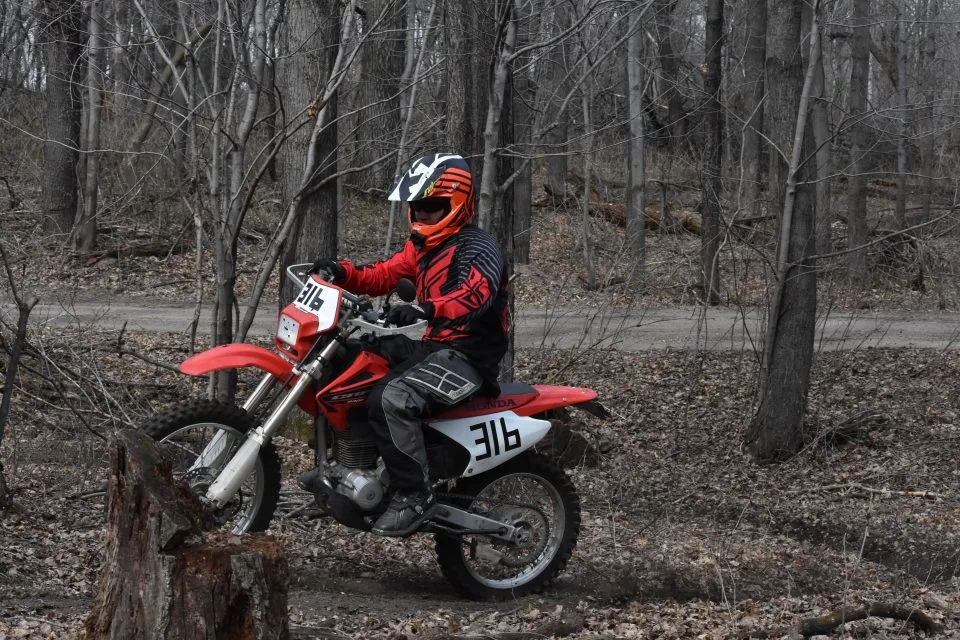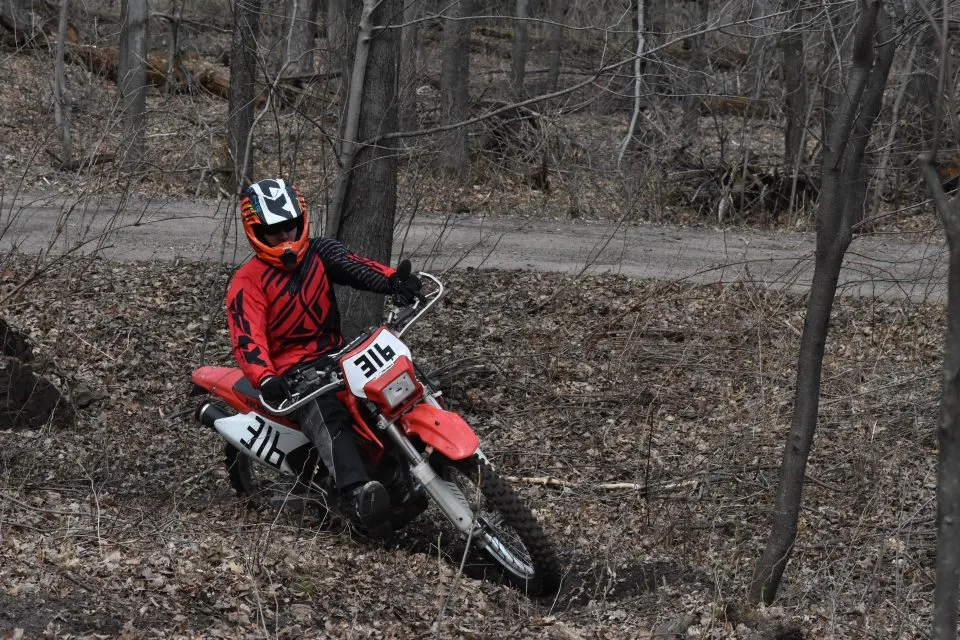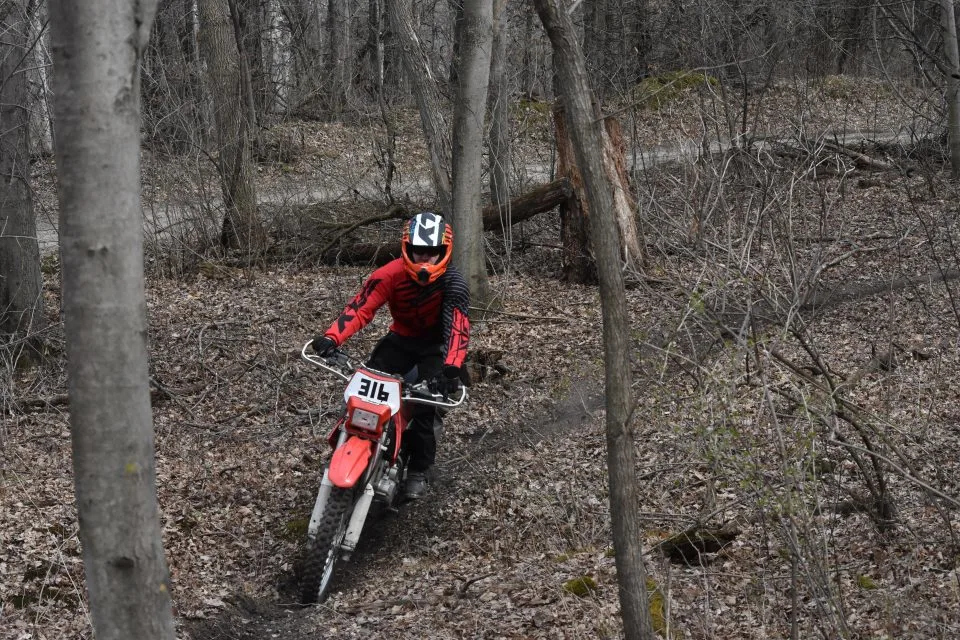Whether you're just learning how to properly ride a dirt bike or you want to ride more efficiently with better control, it's extremely important to use proper body position.
In this article and video, I'm going to show you how to sit on a dirt bike so that you will get more traction and confidence while riding off-road.
How to position yourself on a dirt bike
It all starts with your feet because they are the first thing touching the bike. If you don’t use your feet properly and learn to ‘feel’ the bike and what it’s doing with your feet, you won’t be able to fully stay in control.
Don’t worry though, because this is not something that everyone ‘knows’ right away, which is why I’m teaching you right now. It will come easier and more natural the more you ride if you’re intentionally paying attention to it.
So, how do you position yourself on a dirt bike for maximum control? Here are some practical tips:
- Position the balls of your feet on the pegs
- Keep your toes pointed inward
- Your knees should be slightly bent
- Keep your back straight and your butt back
- Place your elbows slightly up
- Your arms and wrists should be in-line with the bars and levers
- Your head and eyes should be up and looking ahead
- Sit with your butt above the footpegs (this is the "neutral" sitting position)
These are just the basics, but we’ll go into a little more detail on where to sit and when you should sit or stand while riding trails.
Where to sit on the seat
It’s extremely important to learn how to stand up while riding a dirt bike, but you’re going to need to sit down at times to either conserve energy or to have more control. Where you sit on the seat of your dirt bike can make a big difference in your confidence while riding off-road.
It’s easy to lose traction on certain terrain if you’re sitting in the wrong spot or you’re simply not paying attention. Cornering is the most likely place where you’ll lose front-end traction, so let’s start there.

When to start braking
When coming into a corner, you want to be braking early. During braking you want to be sitting on the rear of the seat so that your legs can take most of the force of your body trying to slide forward on the seat.
Once you come into the corner, you want to be done braking and move to the front of the seat in most situations - the more slippery the terrain, the further forward you want to be.

Where to sit on a flat corner
If there’s no rut or berm, you want to be sitting on the outside edge of the seat to put more weight on the tires for better traction and confidence.
So if you’re turning left on a flat corner, then you want to sit on the front right part of the seat for best front-end traction.
What about downhill?
Switching to riding downhill, you want to be on the rear of the seat. This keeps your weight back and much less likely to go over the handlebars.
Learning proper braking technique is also important for riding downhill as well as all other types of terrain.
Are you supposed to stand up on a dirt bike?
Yes, you absolutely need to learn how to stand up, but also how to stand up properly on a dirt bike. Using proper body position is key to staying in control to prevent big crashes.
How to stand and shift gears on a dirt bike
First of all, don’t stand straight up. You need to bend at the waist and keep your butt back to be in the comfortable attack position on a dirt bike.
Using this body position with elbows up gives you the most comfort and leverage for your hands using the throttle and your feet to shift gears. You may have to lift your left foot up slightly and stick it under the shift lever to shift up if your boots are new or stiff.

Stand or sit on single track trails?
Great question, but it really depends on the section of trail you’re riding. I like to sit as much as possible if it’s a smooth trail because it’s usually easier for cornering.
However, if the trail is rough or if I need to use my body more for weaving or riding over obstacles then I will stand to better control the bike.
What should you NOT do while riding a dirt bike?
Here’s some common mistakes that new riders make that cause you to ride with less control and more likely to make you crash:
- Sit at all times while riding
- Use all 4 fingers to brake or use the clutch
- Don’t keep a finger on each lever
- Keep your toes pointed out on the pegs while riding
- Look just past your front fender without looking ahead
How to make sharp turns without falling!
Want to ride tight or sharp turns without falling over? I created a troubleshooting guide that reveals the specific problems most trail riders struggle with, why they happen, and the simple solution. Click here to learn more.



Black Widow Survivor
Friday 17th of December 2021
Before you plan on operating any motorcycle off-road or on-road the bike has to have a thorough inspection for any worn or loose parts especially any leaking gaskets/seals that could throw any lubricant on the tire or brake rotor surfaces? Both are a serious safety issue if found Before operating any motorcycle! Gaskets & leaking seals on any manf. motorcycle are the norm unfortunately & is the only negative side of owning any motorcycle! Fortunately they are pretty simple to detect since most are visible on the outside of the motorcycle! The only off-road motorcycle that I owned that did not matter to inspect before operating the bike was the 1977 CanAm 175-250 MX3/Black Widow! It was not named the Black Widow for nothing! The Bike was designed to dangerous from the manf. to operate & production was stopped! I found out that every time you operated the MX3 it always handled & rode different! So it made you think that you were always on a different bike? Very crazy designed motorcycle! I'm probably the only owner of the MX3 Black Widow that never was injured while operating this handful of motocross designed bike! It's called being blessed or just very lucky or both!